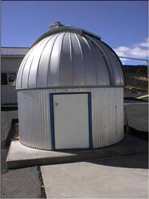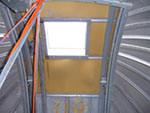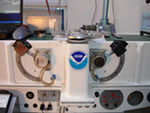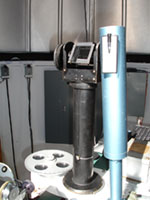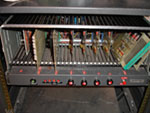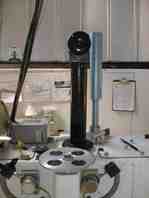More than two years after road access and electrical power to the Mauna Loa Observatory was cut off by lava flows, NOAA staff continue to make critical measurements of the atmosphere and other environmental variables at the remote site.
In 2023, observatory staff installed solar panels at the site and resumed some measurements, including the independent carbon dioxide monitoring programs run by the Global Monitoring Laboratory and Scripps Institution of Oceanography, as well as other atmospheric measurements.
Construction of a temporary road to access the observatory site is anticipated to begin in summer 2025.
Media can contact: Theo Stein (303) 819-7409 (theo.stein@noaa.gov)
Organization(s):
 National Oceanic and Atmospheric Administration (NOAA),
National Oceanic and Atmospheric Administration (NOAA),
Earth System Research Laboratory (ESRL)
What does this program measure?
Total Column Ozone is the amount of ozone in the atmosphere above the station (MLO). As the vast majority (~90%) of the ozone is in the stratosphere, the value is representative of the thickness of the ozone layer. The value is expressed in Dobson Units (DU) – the thickness of a separate layer of pure zone at sea level temperature (15 degrees Celsius) and pressure. A representative value for MLO is 275 DU (a layer of pure ozone 2.75 millimeters thick).
How does this program work?
The Dobson Spectrophotometer 76 measures how fast Ultraviolet (UV) radiation decreases in the 300-340 Nanometer wavelength range. The more ozone, the greater the difference in intensity between the longer and shorter wavelengths. The Dobson is measured three times per day on weekdays at MLO.
Why is this research important?
Ozone controls the amount of UV radiation reaching the earth’s surface. It contributes to the heat balance of the atmosphere, and can be used as an air mass tracer.
Are there any trends in the data?
The plot below shows the running Dobson record at MLO.
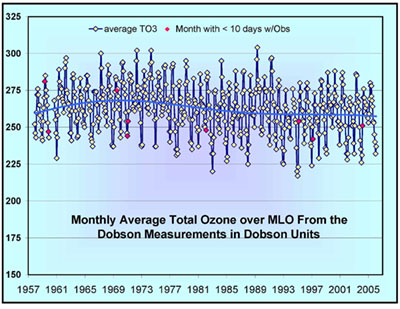
The plot below shows the yearly Dobson Ozone cycle at MLO with the UV correlation.
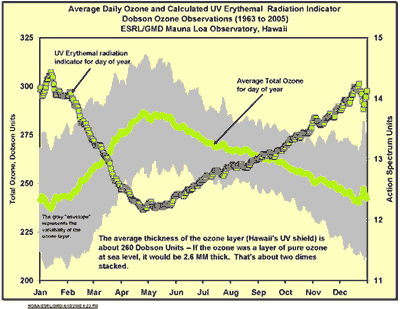
The plot below shows a monthly average total ozone at MLO from 1964-2005. Similar data from other CMDL stations is available on a pdf document. ( Download PDF)

How does this program fit into the big picture?
What is it's role in global climate change?
Ozone is a major player in the radiative balance of the stratosphere. Long term changes in the amount and distribution of stratospheric ozone are both indicators and results of temperature and circulation changes.
Comments and References
Dobson Dome with sunset at MLO
(courtesy of Forrest M. Mims III)
Lead Investigator(s):
Sam Oltmans
303-497-6676
Robert Evans
303-497-6679
MLO Contact(s):
Darryl Kuniyuki808-933-6965 (x236)
David Nardini
808-933-6965 (x229)
Web Site(s)
http://gml.noaa.gov/ozwv/dobson/
Date Started
1958
Related Programs
ESRL World Standard Dobson
Ozone / Water Vapor

